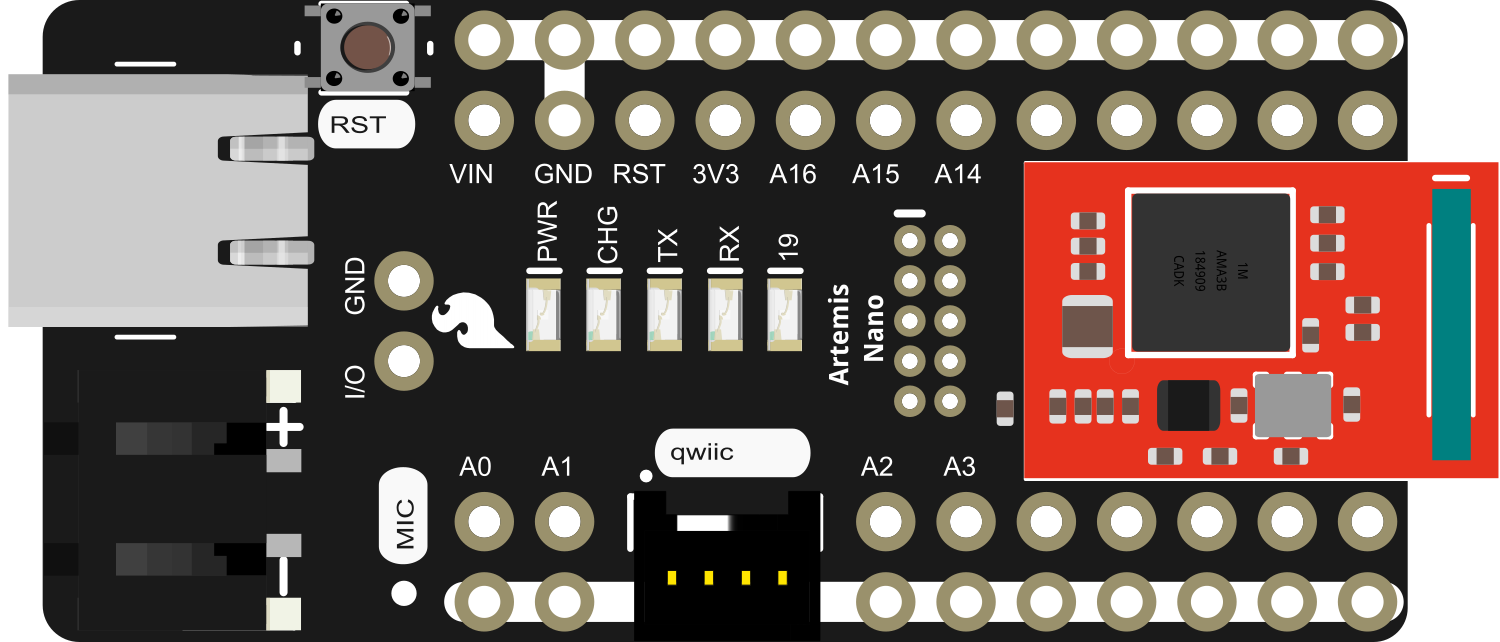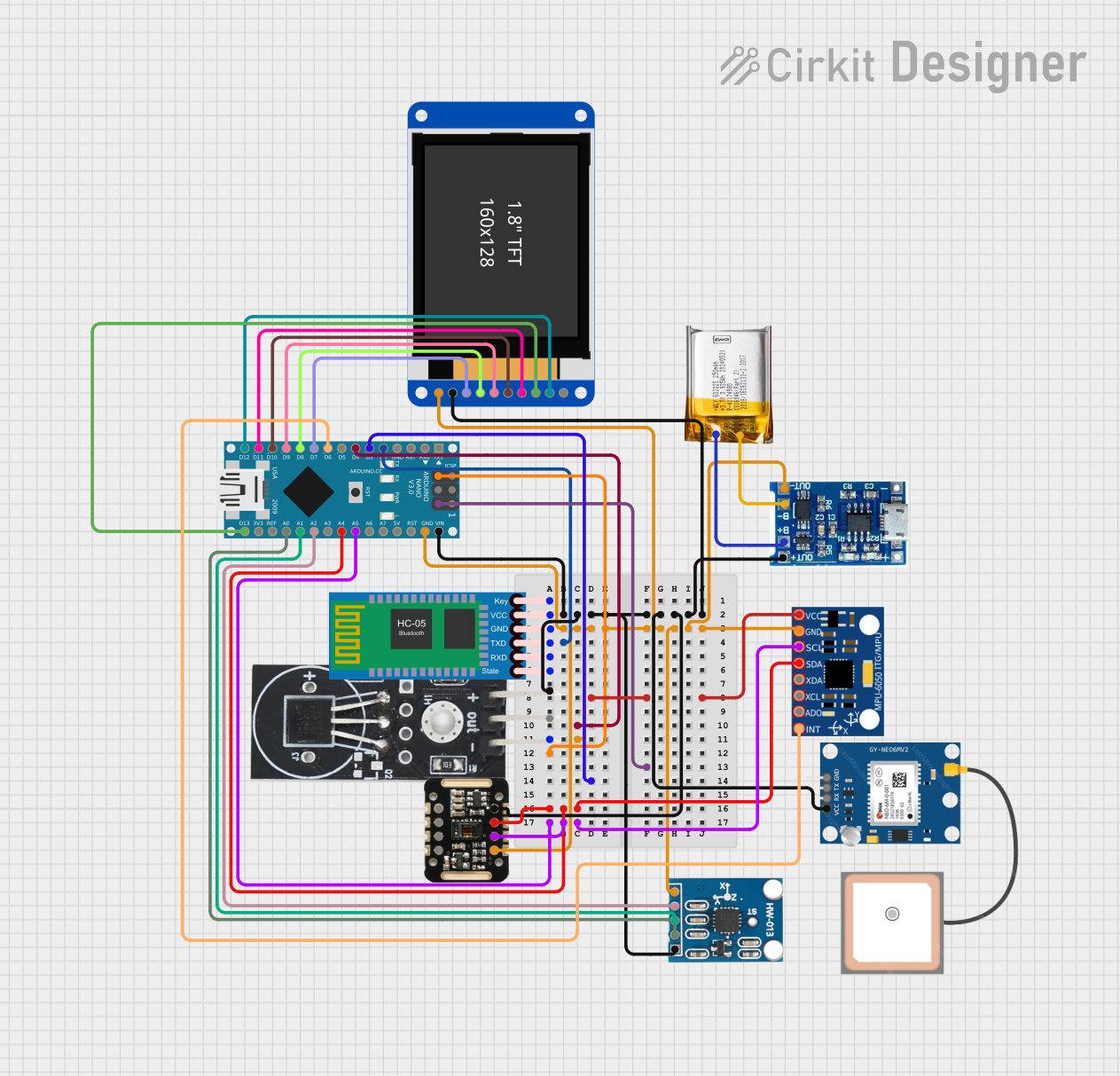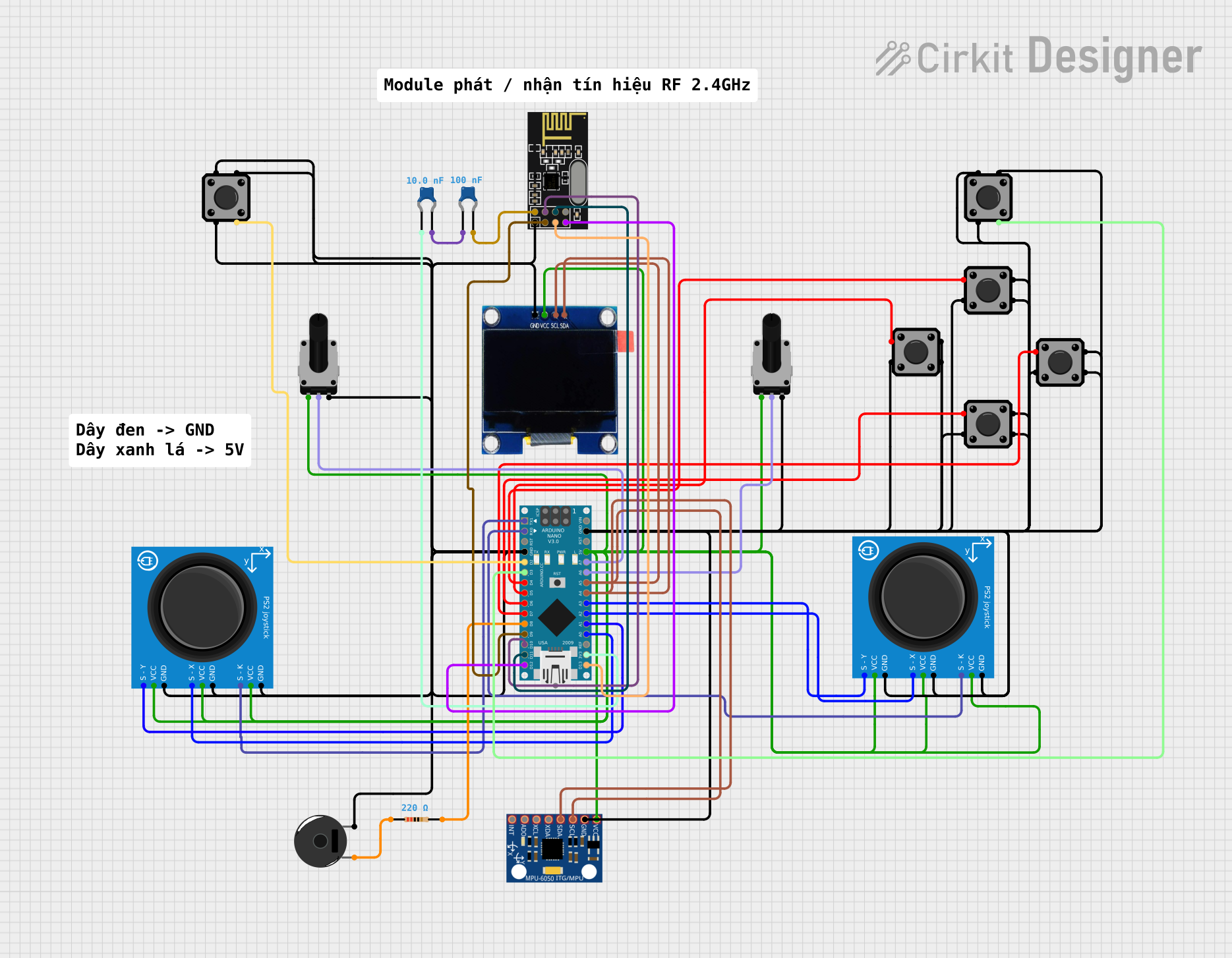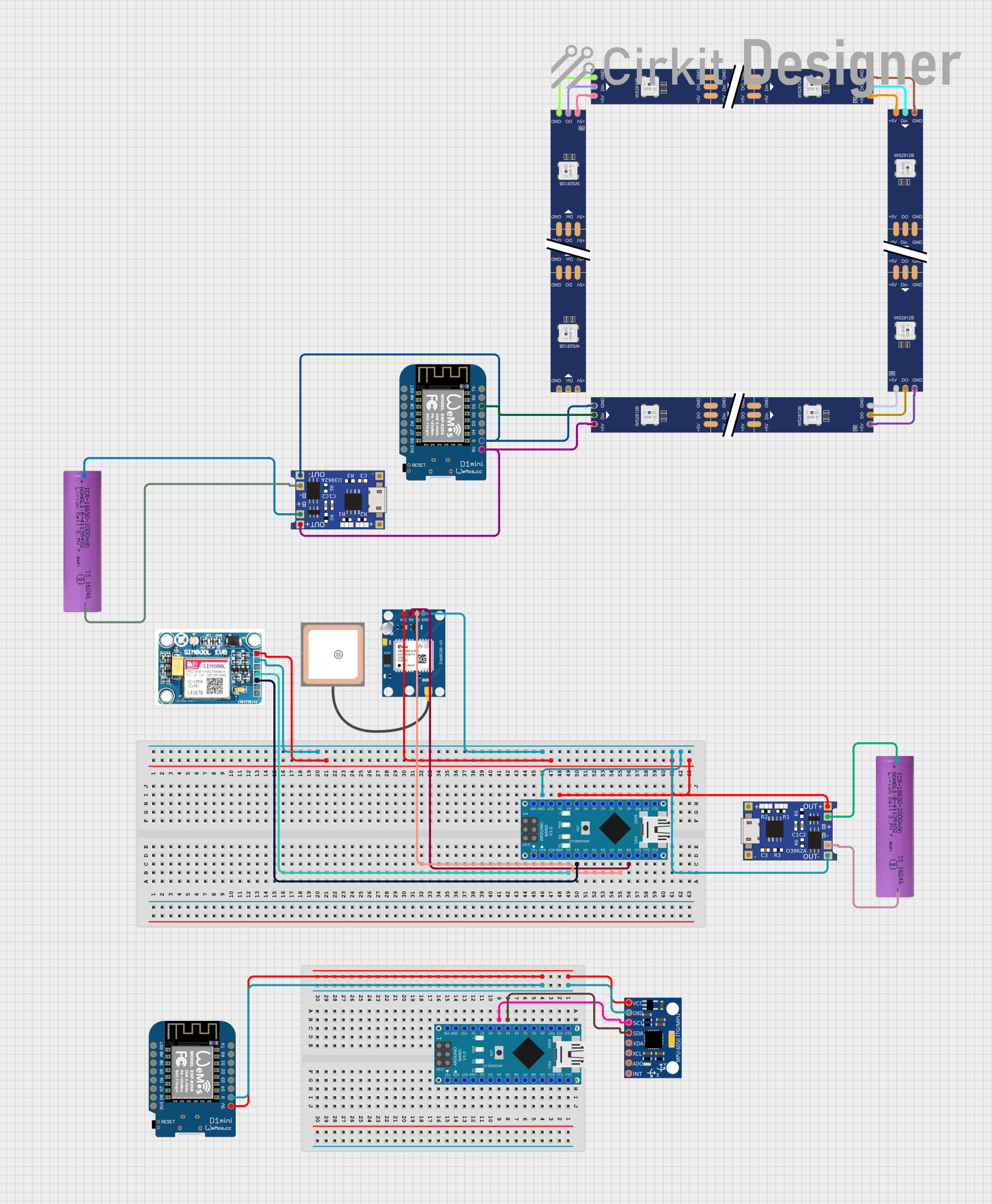
How to Use SparkFun BlackBoard Artemis Nano: Examples, Pinouts, and Specs

 Design with SparkFun BlackBoard Artemis Nano in Cirkit Designer
Design with SparkFun BlackBoard Artemis Nano in Cirkit DesignerIntroduction
The SparkFun BlackBoard Artemis Nano is a compact, high-performance development board designed around the powerful Ambiq Apollo3 microcontroller. It is part of SparkFun's Artemis family of products, which are aimed at providing a suite of advanced features for a variety of applications, including wearables, gesture recognition, and edge computing. The Artemis Nano is particularly well-suited for projects requiring a small form factor, low power consumption, and wireless connectivity.
Explore Projects Built with SparkFun BlackBoard Artemis Nano

 Open Project in Cirkit Designer
Open Project in Cirkit Designer
 Open Project in Cirkit Designer
Open Project in Cirkit Designer
 Open Project in Cirkit Designer
Open Project in Cirkit Designer
 Open Project in Cirkit Designer
Open Project in Cirkit DesignerExplore Projects Built with SparkFun BlackBoard Artemis Nano

 Open Project in Cirkit Designer
Open Project in Cirkit Designer
 Open Project in Cirkit Designer
Open Project in Cirkit Designer
 Open Project in Cirkit Designer
Open Project in Cirkit Designer
 Open Project in Cirkit Designer
Open Project in Cirkit DesignerCommon Applications and Use Cases
- Wearable devices
- Fitness and health monitoring systems
- Gesture-controlled gadgets
- Portable instrumentation
- IoT and edge computing devices
- Educational platforms for learning embedded systems and programming
Technical Specifications
Key Technical Details
- Microcontroller: Ambiq Apollo3 ARM Cortex-M4F
- Operating Voltage: 3.3V
- Input Voltage: 5V (via USB-C) or 3.3V to 6V (via Battery)
- Max Current Supply: 1A
- Digital I/O Pins: 11
- Analog Input Pins: 4
- PWM Output: 10
- UARTs: 1
- I2C Buses: 1
- SPI Buses: 1
- Qwiic Connector: Yes
- Flash Memory: 1MB
- SRAM: 384KB
- Clock Speed: 48MHz
- Bluetooth: BLE 5.0
Pin Configuration and Descriptions
| Pin Number | Function | Description |
|---|---|---|
| 1 | GND | Ground |
| 2 | 3.3V | 3.3V power supply |
| 3-5 | Analog Inputs | A0-A2, 14-bit ADC |
| 6-8 | PWM Outputs | PWM capable pins |
| 9 | RX1 | UART receive pin |
| 10 | TX1 | UART transmit pin |
| 11 | I2C SCL | I2C clock line |
| 12 | I2C SDA | I2C data line |
| 13 | SPI SCK | SPI clock line |
| 14 | SPI MISO | SPI Master In Slave Out |
| 15 | SPI MOSI | SPI Master Out Slave In |
| 16 | Qwiic SCL | Qwiic I2C clock line (connected to pin 11) |
| 17 | Qwiic SDA | Qwiic I2C data line (connected to pin 12) |
| 18 | RST | Reset pin |
| 19 | 5V | 5V power supply (USB or VIN) |
| 20 | GND | Ground |
Usage Instructions
How to Use the Component in a Circuit
Powering the Board:
- Connect the USB-C cable to the board and your computer to power the board.
- Alternatively, supply power through the VIN pin (3.3V to 6V).
Connecting Peripherals:
- Use the I2C pins (SCL, SDA) to connect I2C compatible sensors or devices.
- SPI devices can be connected using the SPI pins (SCK, MISO, MOSI).
- PWM outputs can be used to control motors or LEDs.
- Analog inputs can be used to read sensors like potentiometers or temperature sensors.
Programming the Board:
- The board is programmable using the Arduino IDE or other preferred development environments that support the Ambiq Apollo3 microcontroller.
- Select the appropriate board and port in your IDE before uploading your code.
Important Considerations and Best Practices
- Always ensure that the power supply is within the specified range to prevent damage.
- When connecting peripherals, make sure they are compatible with the board's logic level (3.3V).
- Disconnect the board from power sources before making or altering connections.
- Use the onboard Qwiic connector for easy daisy-chaining of I2C devices without soldering.
Example Code for Arduino UNO
// Example Blink Code for SparkFun BlackBoard Artemis Nano
void setup() {
pinMode(LED_BUILTIN, OUTPUT); // Set the built-in LED pin to be an output
}
void loop() {
digitalWrite(LED_BUILTIN, HIGH); // Turn the LED on
delay(1000); // Wait for a second
digitalWrite(LED_BUILTIN, LOW); // Turn the LED off
delay(1000); // Wait for a second
}
Troubleshooting and FAQs
Common Issues
Board not recognized by the computer:
- Ensure the USB cable is properly connected and the computer's USB port is functioning.
- Try a different USB cable or port to rule out hardware issues.
Unable to upload code:
- Check that the correct board and port are selected in the IDE.
- Ensure the board's drivers are installed correctly.
Peripherals not working:
- Verify that all connections are secure and correct.
- Ensure that the peripheral is compatible with the board's logic level.
Solutions and Tips for Troubleshooting
- If the board is not recognized, press and hold the reset button for a few seconds to reset the board.
- When encountering issues with uploading code, check the IDE's console for error messages that can provide clues.
- For peripheral issues, consult the datasheet of the peripheral to ensure proper usage and compatibility.
FAQs
Q: Can the Artemis Nano be used with a battery? A: Yes, it can be powered with a battery connected to the VIN pin.
Q: Is the Artemis Nano compatible with all Arduino libraries? A: While many libraries will work, some may need modifications due to differences in hardware.
Q: How do I use Bluetooth functionality? A: Bluetooth functionality can be accessed through the Ambiq Apollo3 SDK or libraries specifically designed for the Artemis module.
Q: What is the maximum voltage that can be applied to the analog inputs? A: The maximum voltage for the analog inputs is 3.3V. Applying more can damage the board.